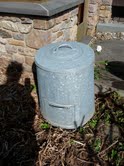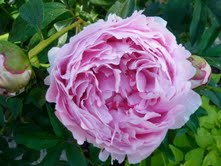Now is the perfect time to start a compost pile. You can do it fancy or simple. And if you know me, you know I always prefer simple. Compost is the most important thing you can use in your garden to improve your land's fertility (lawn, garden, and landscape), get rid of kitchen and yard waste efficiently, and save time and money. The only science involved is the science of decomposition--when things decompose, they turn into the most potent, valuable fertilizer on the market. Why buy it in the store when you can make it at home for free?
Step One: Figure out where to put it, and if you need to put it in something. If you are lucky to live on a nice patch of land, you can simply make a compost pile in a back corner somewhere. You don't really need a container to make compost. However, if you live on a smaller patch of land, you might want to get a container to keep things looking tidy. I have tried lots of containers over the years. My husband's favorite is probably the compost tumbler, mainly because he can move it close to the kitchen door in the winter. My favorite container is one I had shipped over from England, mostly because it looks beautiful in my veggie garden. We keep our compost containers right in the veggie patch, since that's where most weeds and veggie leftovers go in, and where the good black gold comes out. If you live in the city, you probably will want a container. All compost containers (except for the compost tumbler) look kind of like trash cans, but without a bottom, so the good microbes from the soil can get in and do their business. If you have an old trash can lying about, you can just cut off the bottom, and voilà! You have a composter.

This is a picture of me taking a picture (with my iphone) of my favorite composter from England.
Step Two: Start collecting stuff to put on your pile. From outside the house, you can put weeds (but not poison ivy please), leaves, old dying plant material, and garden waste. From inside the house, you can get a fancy compost bucket for your kitchen sink if you like, or you can just use a bucket or old container to collect kitchen waste. Things to avoid putting on the compost pile include anything toxic, meat, bones, processed foods, dairy, and pet poop. But any other kitchen waste from vegetables or fruits, egg shells, coffee or tea grounds and even the shells of things like clams and crab are good, really good. Take this stuff out to your pile daily, otherwise it starts to decompose inside the house instead of outside the house, and might start to smell. Keep your waste container clean between loads, and you will have a clean-smelling, efficient composting operation set up in your household.
Step Three: Wait. Some people, compost connoisseurs, may have all sorts of elaborate rituals and techniques for speeding up the composting process. But it never fails if you just wait. Keep on adding to the top, and in a few months, at the bottom, you will have rich, dark, fertile compost to spread around. (That's why a lot of composters have little doors at the bottom--no, it's not for the composting gnomes to get in to do their job!...Or is it?)

Alas, the peonies are now done blooming, but it just goes to show what a little compost can do!
Step Four: Use it. If you don't use it, you won't lose it...it just waits for you. And even if you never use it, you've already done great work by keeping waste out of the public waste stream. However, compost loves to be used. You can spread it lightly on your lawn to make it greener. You can put it on your veggie patch to make it grow bigger, healthier, stronger veggies. You can put it on your flower beds to make your flowers more luscious and pest-resistant. You can sprinkle it around your houseplants or container plants. You can package it nicely and give it to friends and neighbors.
Compost is an organic gardener's most powerful tool for raising healthy, pest-free, and beautiful gardens. Now there is nothing stopping you from getting started!
Related Links:
Secret Organic Weapon for Weeding - Maria's Farm Country Kitchen
How Compost Turns Yard Waste into Black Gold - Rodale.com
5 Tips for Starting A Sustainable Vegetable Garden - Organic Authority
For more from Maria Rodale, go to www.mariasfarmcountrykitchen.com.
